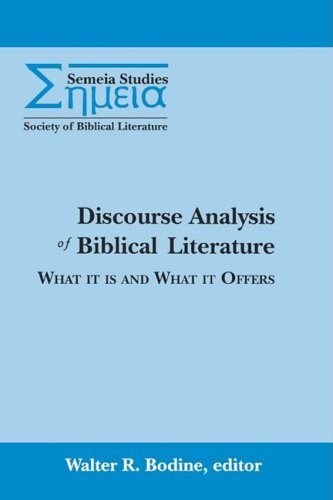 Discourse Analysis of Biblical Literature: What it Is and What it Offers
Discourse Analysis of Biblical Literature: What it Is and What it Offers. Edited by
Walter Ray Bodine. The Society of Biblical Literature Semeia Studies. (Scholars Press, 1995), 274 pages.
Walter Bodine opens the work with an essay on a brief history of discourse analysis and why biblical scholars should be interested in it. In conclusion, Bodine says the “purpose of the volume is to encourage biblical scholars to join in welcoming into their circle this now established and rapidly growing field (11).
In chapter 1, Robert Longacre examines Exodus 25:1-30:10 with the intention to “delineate clearly instruction as a discourse type and to present in some detail the structure and discourse-effectiveness of this passage” (23). He examines both the macrostructure of each section, as well as microstructures within each section, explains the discourse features of the Hebrew.
In chapter 2, David M. Carr examines Isa 40:1-11 and its function in chapters 40-66 using a method of descending text analysis developed by Elizabeth Gühlich and Wolfgang Raible. He concludes that Isa 40:1-8 is a “prophetic call report,” placed at the beginning of the prophetic writing to “validate the following message through reference to the prophet’s divine commission (59-60).
In chapter 3, Randall Buth discusses functional grammar for Hebrew and Aramaic. “A functional grammar is one that includes pragmatic information in the core of the grammar” (78). He argues for a pragmatic function to the SVO/VSO order, as well as for fronting. Especially interesting is that SVO can be used to mark peak or dramatic pause, as in Esth 7:6-10, where a chain of SVO clauses are found leading to the climax of the story.
In chapter 4, Kirk E. Lowery provides the theoretical foundations for Hebrew discourse grammar. He classifies four groups of discourse analysis: psycho-social, anthropological, cognitive, and grammatical. He argues that the grammatical approach is the best option to better understand Hebrew and its discourse. The best way to recognize discourse features of Biblical Hebrew is through (proper) statistical analysis (119). We should not impose our Latin grammatical concepts onto the Hebrew language unless these categories are confirmed through analysis.
In chapter 5, Tova Meltzer provides a brief summary of the history of “style” in studies on literature and linguistics. Advances in linguistic theory led to a more neutral view of style, and to the recognition that “the notion of style depends upon consideration of text, that is, language as discourse” (137). “Style” has not “evaporated as a meaningful term in language description; the ‘data of style,’ however, have stimulated exciting new dimensions in language research (141).
In chapter 6, Cynthia L. Miller argues against the traditional understanding of l’mr as a gerundive use of the infinitive that marks direct speech (168). Miller concludes as follows: “Frames with [l’mr] are used to indicate that the reported speech event is less than prototypically dialogic. They are used to introduce information into the narrative without recourse to representation of the entire dialogic exchange. They are used to introduce speech acts of unknown or anonymous persons, that is, persons who are less than full characters in the narrative. Finally, they are used to relate a series of embedded quotations all of which are reported from the perspective of the principal” (178).
In chapter 7, Douglas M. Gropp discusses the discourse function of prepositions ke and be with infinitive construct. Ke + infinitive construct functions fairly consistently as a “backreferencing device,” whereas be + infinitive construct can achieve the same, or it can be used for resumption of a narrative, flashback, or establishing a new setting (202). It could possibly be said that ke + infinitive construct marks for succession while be + infinitive construct “is merely unmarked for succession, and takes on the implicature of simultaneity only through context” (209).
Positively, this work provides many different analyses of Hebrew language-in-use. It also provides detailed analyses of specific discourse features of various words and syntactical structures. Negatively, as with other works of this kind, there is no methodology laid out for carrying out discourse analysis. There are only various kinds of analyses, using slightly different methodologies themselves, from which one can glean elements to incorporate into one’s own method for discourse analysis. In sum, those who wish to apply discourse analysis to the OT should certainly consult this work.
Find it here on Amazon.
